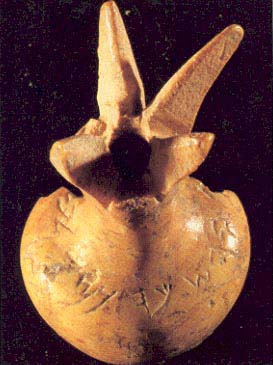Image Details

Courtesy André Lemaire
The inscription on the shoulder of the eighth-century B.C. ivory pomegranate. The inscription begins at the upper left, where three letters can be seen separated from the others by a space, and continues around the pomegranate clockwise, interrupted in the back where the pomegranate is broken. The author reads the inscription as follows (bracketed letters are assumed to fill the broken area in the shoulder): lby³ [t yhw]h³ qdsû khnm, which he translates as “Belonging to the Tem[ple of the Lor]d, holy to the priests.” The shape of the letters provides the most important clue to the date of the pomegranate. The letters are very similar to the script of the so-called Siloam Inscription, which was cut into the wall of a tunnel King Hezekiah built in about 705 B.C. to bring water from the Gihon Spring inside the walls of Jerusalem.
